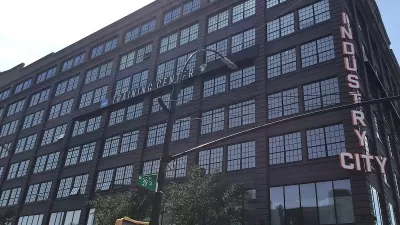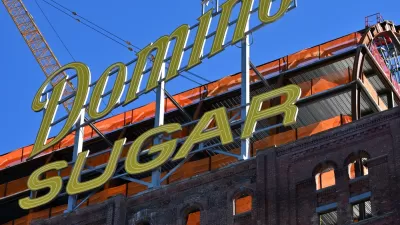80 Flatbush, a major high-rise development combining apartments, offices, and community amenities, lies at the center of ongoing debate between YIMBYs and neighborhood character advocates.

New York City development debates have come to a head this spring around a 986-foot-tall mixed-use tower complex to be sited between downtown Brooklyn and Boerum Hill. Joe Anuta writes, "arguments in favor of respecting the low-rise environment are colliding into a central tenet of the city's planning strategy: build housing near public transit. In this case, there are few mass-transit hubs in the city more vital and connected than the Atlantic Avenue–Barclays Center station a block away."
The project's critics expected a more modest form of development on the site. "Opponents of Alloy's project have said that the site—a trapezoidal block between Flatbush and Third avenues and State and Schermerhorn streets—was mapped within the footprint of the Boerum Hill Association and envisioned as a medium-density buffer around the skyscrapers farther north." Those skyscrapers already include the 1,066-foot-tall 9 DeKalb Avenue, currently under construction.
In early May, Brooklyn Community Board 2 voiced its opposition to the proposed rezoning in a resounding vote, as Norman Oder reports in an in-depth look at the issue. That vote was an advisory one, and the debate continues. Oder writes, "it's unclear how much the vote will influence Borough President Eric Adams, whose recommendation is also advisory but represents a broader constituency, and Council Member Stephen Levin (District 33), who holds the key voice on the City Council."
FULL STORY: Developer attempts to push the limits on border of brownstone Brooklyn

Planetizen Federal Action Tracker
A weekly monitor of how Trump’s orders and actions are impacting planners and planning in America.

Map: Where Senate Republicans Want to Sell Your Public Lands
For public land advocates, the Senate Republicans’ proposal to sell millions of acres of public land in the West is “the biggest fight of their careers.”

Restaurant Patios Were a Pandemic Win — Why Were They so Hard to Keep?
Social distancing requirements and changes in travel patterns prompted cities to pilot new uses for street and sidewalk space. Then it got complicated.

Platform Pilsner: Vancouver Transit Agency Releases... a Beer?
TransLink will receive a portion of every sale of the four-pack.

Toronto Weighs Cheaper Transit, Parking Hikes for Major Events
Special event rates would take effect during large festivals, sports games and concerts to ‘discourage driving, manage congestion and free up space for transit.”

Berlin to Consider Car-Free Zone Larger Than Manhattan
The area bound by the 22-mile Ringbahn would still allow 12 uses of a private automobile per year per person, and several other exemptions.
Urban Design for Planners 1: Software Tools
This six-course series explores essential urban design concepts using open source software and equips planners with the tools they need to participate fully in the urban design process.
Planning for Universal Design
Learn the tools for implementing Universal Design in planning regulations.
Heyer Gruel & Associates PA
JM Goldson LLC
Custer County Colorado
City of Camden Redevelopment Agency
City of Astoria
Transportation Research & Education Center (TREC) at Portland State University
Camden Redevelopment Agency
City of Claremont
Municipality of Princeton (NJ)





























